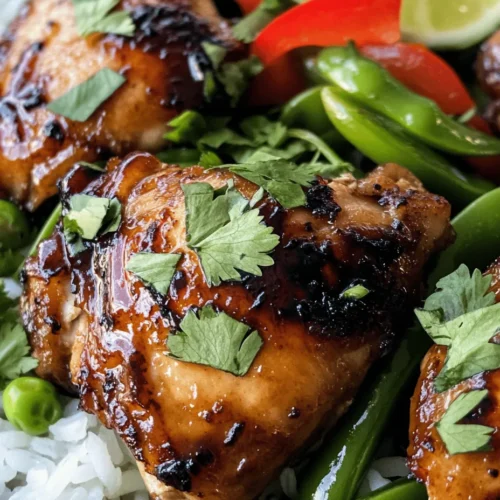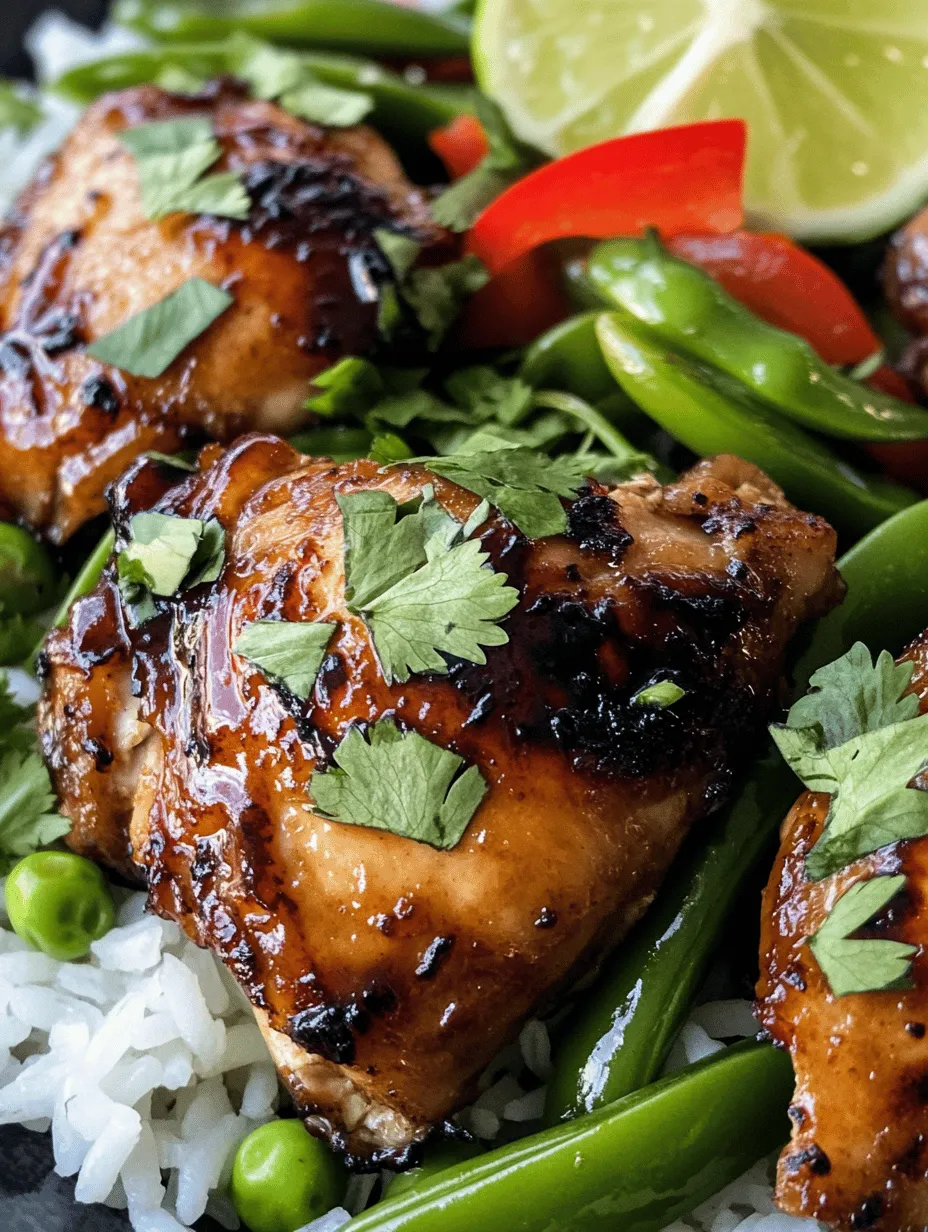Introduction
Thai cuisine is renowned worldwide for its vibrant flavors, fresh ingredients, and harmonious balance of sweet, sour, salty, and spicy elements. Each dish tells a story, and one of the standout recipes that beautifully encapsulates this culinary art is Sweet and Spicy Thai Chicken. This dish has gained immense popularity not only for its tantalizing taste but also for its versatility; it can be served as a quick weeknight dinner or as a show-stopping entrée at a gathering.
Sweet and Spicy Thai Chicken combines tender chicken thighs marinated in a symphony of bold flavors, resulting in a dish that excites the palate. The marriage of sweet honey and fiery Sriracha creates a deliciously complex sauce that clings to the chicken, while the aromatic garlic and ginger elevate the dish to new heights. This recipe is not just about cooking; it’s about creating an experience that transports you to the bustling streets of Thailand, where food is a celebration.
In this article, we will delve into the essence of Sweet and Spicy Thai Chicken, exploring the ingredients that make it a favorite among many and guiding you through the preparation and cooking process to ensure your dish is nothing short of perfection.
Understanding the Ingredients
To master Sweet and Spicy Thai Chicken, it’s essential to understand the role of each ingredient. Let’s break down the key components that contribute to the dish’s enticing flavor profile:
Chicken Thighs
Using boneless and skinless chicken thighs is a game-changer in this recipe. Chicken thighs are inherently juicier and more flavorful than chicken breasts, which can easily dry out during cooking. The richness of the thighs complements the vibrant marinade, allowing the flavors to penetrate deeply. Additionally, the fat content in chicken thighs ensures that the meat remains tender and succulent, making for a satisfying bite with every forkful.
Vegetable Oil
Vegetable oil is a vital ingredient in this recipe, primarily used for sautéing the chicken. It has a high smoke point, making it ideal for frying and ensuring that the chicken develops a golden-brown crust. This oil also serves as a neutral base, allowing the flavors of the marinade to shine through without overpowering them.
Garlic and Ginger
Both garlic and ginger are cornerstones of Thai cuisine, offering a punch of flavor and aroma that enhances the overall dish. Garlic brings a savory depth, while ginger adds a warm, zesty note that brightens the palate. Together, they create a fragrant foundation that elevates the chicken and makes every bite a delightful experience.
Soy Sauce and Fish Sauce
These two ingredients are the umami powerhouses of Thai cooking. Soy sauce is rich in savory flavors, while fish sauce introduces a unique saltiness and complexity that is hard to replicate. Together, they provide a perfect balance of salty and savory notes that infuse the chicken with deep flavor. When used in moderation, they enhance the dish without overwhelming it, making them essential to the marinade.
Honey and Sriracha
The combination of honey and Sriracha is what makes this dish truly special. Honey adds a natural sweetness that helps to balance the heat of the Sriracha, resulting in a sauce that is both sweet and spicy. This dynamic duo creates a glaze that caramelizes beautifully during cooking, resulting in a sticky, flavorful coating on the chicken that is simply irresistible.
Rice Vinegar and Sesame Oil
Rice vinegar is a staple in many Asian cuisines, bringing acidity that brightens the overall flavor of the dish. It adds a subtle tang that cuts through the richness of the chicken and balances the sweetness of the honey. Sesame oil, on the other hand, contributes a warm, nutty aroma that rounds out the flavor profile. Together, these ingredients add depth and complexity to the marinade.
Vegetables
Incorporating vegetables such as red bell peppers and snap peas not only enhances the nutritional value of the dish but also adds vibrant color and texture. Red bell peppers are rich in vitamins A and C, while snap peas provide a satisfying crunch. These vegetables complement the tender chicken and contribute to the dish’s overall appeal.
Fresh Cilantro and Lime
Finally, no Thai dish would be complete without fresh herbs and a squeeze of citrus. Fresh cilantro adds a burst of herbal brightness that elevates the flavors, while lime juice provides a zesty finish that ties everything together. These ingredients serve as the perfect garnish, adding freshness and making the dish visually appealing.
Marinating the Chicken
One of the key steps in achieving the best flavor for your Sweet and Spicy Thai Chicken is the marination process. Marinating not only infuses the chicken with flavor but also tenderizes the meat, resulting in a more succulent dish.
Importance of Marinating for Flavor Infusion
Marination allows the chicken to absorb the flavors of the marinade, which is particularly important for a dish that relies on a balance of sweet and spicy elements. The longer the chicken marinates, the more pronounced the flavors will be. This step is crucial, as it sets the stage for the dish’s overall taste profile.
Step-by-Step Guide to Creating the Marinade
Creating the marinade for Sweet and Spicy Thai Chicken is a straightforward process that takes just a few minutes. Here’s how to do it:
1. Gather Your Ingredients: Start by collecting all the marinade ingredients: soy sauce, fish sauce, honey, Sriracha, minced garlic, minced ginger, rice vinegar, and sesame oil.
2. Mix the Marinade: In a bowl, combine ¼ cup of soy sauce, 2 tablespoons of fish sauce, 2 tablespoons of honey, 1 tablespoon of Sriracha (adjust to taste), 2 cloves of minced garlic, 1 tablespoon of minced ginger, 1 tablespoon of rice vinegar, and 1 tablespoon of sesame oil. Whisk until well combined.
3. Prepare the Chicken: Take boneless, skinless chicken thighs and place them in a zip-top bag or a shallow dish.
4. Add the Marinade: Pour the marinade over the chicken, ensuring each piece is well-coated. Seal the bag or cover the dish with plastic wrap.
5. Marinate: Allow the chicken to marinate in the refrigerator for at least 30 minutes, but for optimal flavor, aim for 2 to 4 hours. If you have more time, marinating overnight will yield even better results.
Recommended Marination Times for Optimal Taste
While a quick 30-minute marinade will impart some flavor, longer marination times are recommended for maximum taste. If time allows, marinating the chicken for 2 to 4 hours is ideal. For those who wish to prepare ahead, marinating overnight will deepen the flavors significantly. However, avoid marinating for more than 24 hours, as the acids in the marinade can begin to break down the chicken, leading to a mushy texture.
Cooking the Chicken to Perfection
Once your chicken has marinated to perfection, it’s time to cook it. The method you choose can significantly impact the texture and flavor of the final dish.
Explanation of the Cooking Process: Sautéing vs. Other Methods
Sautéing is the recommended cooking method for Sweet and Spicy Thai Chicken, as it allows the chicken to sear quickly, locking in moisture while developing a flavorful crust. This method also gives you the ability to control the cooking temperature, ensuring that the chicken is cooked evenly throughout.
While grilling or baking could also work, sautéing in a hot pan with vegetable oil will give you the best results in terms of flavor and texture. The high heat creates a nice caramelization on the outside while keeping the inside juicy.
Importance of Achieving the Right Internal Temperature
To ensure food safety and the best texture, it’s crucial to cook the chicken to the right internal temperature. Chicken should reach an internal temperature of 165°F (75°C) to be safe for consumption. Using a meat thermometer will help you accurately check the temperature and avoid overcooking, which can lead to dry chicken.
Tips for Perfecting the Texture of Chicken Thighs
For perfectly cooked chicken thighs, follow these tips:
1. Preheat the Pan: Ensure your pan is hot before adding the chicken. This will help achieve a good sear and prevent sticking.
2. Don’t Overcrowd the Pan: Cook the chicken in batches if necessary. Overcrowding can lower the pan’s temperature, resulting in steaming rather than sautéing.
3. Let It Rest: After cooking, allow the chicken to rest for a few minutes before slicing. Resting helps retain moisture, ensuring that each bite is juicy and tender.
By following these steps and tips, you’re well on your way to creating an unforgettable Sweet and Spicy Thai Chicken dish that will delight your taste buds and impress your guests. Stay tuned for the remaining steps in this delicious culinary journey!

Preparing the Vegetables
To create a balanced and delicious Sweet and Spicy Thai Chicken dish, preparing the vegetables is a crucial step. The goal is to retain their crunch and vibrant color while enhancing the overall flavor of the dish. Start by selecting a mix of bell peppers, snap peas, and carrots. These vegetables not only add color but also a variety of textures that complement the tender chicken.
When sautéing vegetables, the technique is key to achieving the desired outcome. Begin by heating a tablespoon of oil in a large skillet or wok over medium-high heat. Once the oil is shimmering, add your vegetables in batches rather than overcrowding the pan. This allows each piece to cook evenly and develop a slight char, which adds depth to the flavor. Sauté for about 3-4 minutes, stirring frequently, until the vegetables are just tender but still crisp.
Garlic and ginger play a pivotal role in this dish, infusing it with aromatic flavors. Mince 2-3 cloves of garlic and a 1-inch piece of fresh ginger, and add them to the pan just as the vegetables are nearly done. Cook for an additional minute until fragrant, ensuring not to burn them, as this can introduce bitterness. Incorporating fresh vegetables not only enhances the taste but also boosts the nutritional profile of the meal, offering vitamins, minerals, and antioxidants essential for good health.
Combining and Glazing
Once your vegetables are perfectly sautéed, it’s time to bring everything together using the reserved marinade. This marinade, packed with flavors, will serve as the base for your sauce. If you had marinated the chicken beforehand, you should have a good amount of liquid that has absorbed the spices and sweetness.
Pour the reserved marinade into the pan with the sautéed vegetables and bring it to a gentle simmer. This simmering process is crucial as it allows the flavors to meld together while reducing the sauce to a thicker consistency. Allow it to cook for about 5-7 minutes, stirring occasionally. The key here is to cook it until the sauce coats the back of a spoon, which indicates it is ready.
Next, introduce the browned chicken pieces back into the pan. Ensure that each piece is coated evenly with the sauce by gently stirring everything together. This step not only ensures that the chicken is flavorful but also helps the vegetables absorb some of the marinade’s sweetness and spice.
To achieve an even coating, consider using a spatula to fold the ingredients together rather than stirring aggressively, which might break the chicken into smaller pieces. Let the combined mixture simmer for another 2-3 minutes, allowing the chicken to heat through and the flavors to intensify.
Serving Suggestions
Presentation is vital when serving Sweet and Spicy Thai Chicken, as it enhances the overall dining experience. Begin by serving the dish over a bed of fluffy jasmine rice, which is the perfect accompaniment to soak up the flavorful sauce. The subtle fragrance and texture of jasmine rice harmonize beautifully with the sweet and spicy notes of the chicken.
For an attractive presentation, consider arranging the chicken and vegetables in a large serving bowl or on individual plates. Drizzle any remaining glaze over the top to make the dish shine. To elevate the visual appeal, garnish with freshly chopped cilantro and wedges of lime. This not only adds a splash of color but also offers a burst of freshness that balances the richness of the dish.
If you’re feeling adventurous, you can also serve the Sweet and Spicy Thai Chicken with additional sides like a simple cucumber salad or spring rolls, which complement the flavors perfectly. The freshness of the salad and the crunch of the spring rolls provide a delightful contrast to the main dish.
Nutritional Information
When it comes to nutrition, Sweet and Spicy Thai Chicken provides a balanced meal that can fit into a healthy dietary regimen. Each serving typically contains around 350-400 calories, depending on the portion size and specific ingredients used. This dish is rich in protein, primarily from the chicken, offering approximately 30 grams per serving, which is essential for muscle repair and growth.
Additionally, the inclusion of a variety of vegetables boosts the fiber content, promoting digestive health and aiding in satiety. The dish also provides a good dose of vitamins A and C from the bell peppers and carrots, as well as potassium and antioxidants from the ginger and garlic.
For those mindful of their caloric intake, consider adjusting the portion sizes or pairing the chicken with a larger portion of vegetables instead of rice. This way, you can enjoy the flavors while keeping the meal light and nutritious.
Variations and Substitutions
One of the best aspects of Sweet and Spicy Thai Chicken is its versatility. If you’re looking for alternative proteins, tofu or shrimp can be great substitutes for chicken. Tofu, when pressed and marinated appropriately, can absorb the flavors beautifully and becomes a satisfying plant-based option. For shrimp lovers, cooking them for just a few minutes until they turn opaque ensures they remain tender.
Adjusting the spice levels is also easy with this recipe. If you prefer milder flavors, reduce the amount of chili paste or omit it altogether. For those who enjoy a kick, consider adding sliced fresh chilies or a dash of hot sauce when serving.
Seasonal vegetables can keep the dish fresh and exciting. In the summer, consider adding zucchini or corn, while in the fall, butternut squash or Brussels sprouts could work beautifully. This adaptability makes it easy to incorporate what’s in season, ensuring the dish remains vibrant and flavorful throughout the year.
Conclusion
Sweet and Spicy Thai Chicken is not just a meal; it’s an experience that brings the vibrant flavors of Thai cuisine right into your home. The combination of tender chicken, crisp vegetables, and a sweet yet spicy glaze creates a dish that is sure to impress. Its versatility allows for various adaptations, making it suitable for any occasion or dietary preference.
We encourage you to try this recipe and savor the delightful fusion of flavors. Whether you are a seasoned chef or a beginner in the kitchen, this dish offers a satisfying way to explore the richness of homemade Thai food. With each bite, you’ll enjoy a taste of Thailand, all while relishing the benefits of a nutritious meal. Embrace the culinary adventure and enjoy the satisfaction of creating something exceptional right from your kitchen!



